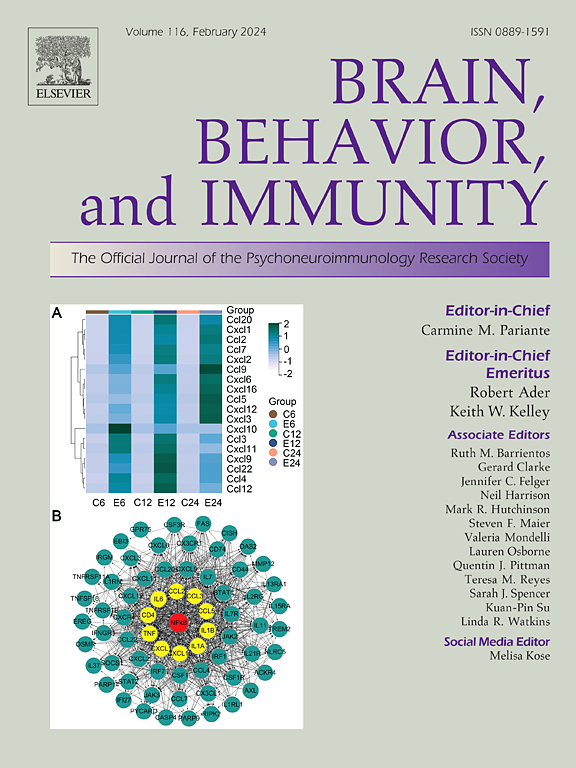HDAC inhibitors engage MITF and the disease-associated microglia signature to enhance amyloid β uptake
IF 8.8
2区 医学
Q1 IMMUNOLOGY
引用次数: 0
Abstract
Disease-associated microglia (DAM), initially described in mouse models of neurodegenerative diseases, have been classified into two related states; starting from a TREM2-independent DAM1 state to a TREM2dependent state termed DAM2, with each state being characterized by the expression of specific marker genes (Keren-Shaul, 2017). Recently, single-cell (sc)RNA-Seq studies have reported the existence of DAM in humans (Pettas, 2022; Jauregui, 2023; Friedman, 2018; Mathys, 2019; Tuddenham, 2024); however, whether DAM play beneficial or detrimental roles in the context of neurodegeneration is still under debate (Butovsky and Weiner, 2018; Wang and Colonna, 2019). Here, we present a pharmacological approach to mimic human DAM in vitro: we validated in silico predictions that two different histone deacetylase (HDAC) inhibitors, Entinostat and Vorinostat, recapitulate aspects of the DAM signature in two human microglia-like model systems. HDAC inhibition increases RNA expression of MITF, a transcription factor previously described as a regulator of the DAM signature (Dolan, 2023). This engagement of MITF appears to be associated with one part of the DAM signature, refining our understanding of the DAM signature as a combination of at least two transcriptional programs that appear to be correlated in vivo. Further, we functionally characterized our DAM-like model system, showing that the upregulation of this transcriptional program by HDAC inhibitors leads to an upregulation of amyloid β and pHrodo Dextran uptake – while E.coli uptake is reduced – and a specific reduction of MCP1 secretion in response to IFN-γ and TNF-α. Enhanced amyloid β uptake was confirmed in iPSC-derived microglia. Overall, our strategy for compound-driven microglial polarization offers potential for exploring the function of human DAM and for an immunomodulatory strategy around HDAC inhibition.
HDAC抑制剂参与MITF和疾病相关的小胶质细胞特征,以增强淀粉样蛋白β的摄取。
疾病相关小胶质细胞(DAM),最初在神经退行性疾病的小鼠模型中被描述,已被分为两种相关状态;从不依赖TREM2的DAM1状态到依赖TREM2的DAM2状态,每种状态都以特定标记基因的表达为特征(Keren-Shaul, 2017)。最近,单细胞(sc)RNA-Seq研究报道了人类中存在dam (Pettas, 2022;哈乌雷吉曾,2023;弗里德曼,2018;数学,2019;Tuddenham, 2024);然而,dam在神经退行性变中是否起有益或有害的作用仍在争论中(Butovsky和Weiner, 2018;Wang and Colonna, 2019)。在这里,我们提出了一种体外模拟人类DAM的药理学方法:我们在计算机上验证了两种不同的组蛋白去乙酰化酶(HDAC)抑制剂,恩替诺他和伏立诺他,在两种人类小胶质样模型系统中概括了DAM特征的方面。HDAC抑制增加MITF的RNA表达,MITF是一种转录因子,以前被描述为DAM特征的调节因子(Dolan, 2023)。MITF的这种参与似乎与DAM特征的一部分有关,这使我们进一步理解DAM特征是至少两个转录程序的组合,这两个转录程序在体内似乎是相关的。此外,我们在功能上表征了我们的dam样模型系统,表明HDAC抑制剂上调该转录程序导致淀粉样蛋白β和pHrodo葡聚糖摄取上调,而大肠杆菌摄取减少,并在IFN-γ和TNF-α的反应中特异性减少MCP1分泌。总的来说,我们的化合物驱动的小胶质细胞极化策略为探索人类DAM的功能和围绕HDAC抑制的免疫调节策略提供了潜力。
本文章由计算机程序翻译,如有差异,请以英文原文为准。
求助全文
约1分钟内获得全文
求助全文
来源期刊
CiteScore
29.60
自引率
2.00%
发文量
290
审稿时长
28 days
期刊介绍:
Established in 1987, Brain, Behavior, and Immunity proudly serves as the official journal of the Psychoneuroimmunology Research Society (PNIRS). This pioneering journal is dedicated to publishing peer-reviewed basic, experimental, and clinical studies that explore the intricate interactions among behavioral, neural, endocrine, and immune systems in both humans and animals.
As an international and interdisciplinary platform, Brain, Behavior, and Immunity focuses on original research spanning neuroscience, immunology, integrative physiology, behavioral biology, psychiatry, psychology, and clinical medicine. The journal is inclusive of research conducted at various levels, including molecular, cellular, social, and whole organism perspectives. With a commitment to efficiency, the journal facilitates online submission and review, ensuring timely publication of experimental results. Manuscripts typically undergo peer review and are returned to authors within 30 days of submission. It's worth noting that Brain, Behavior, and Immunity, published eight times a year, does not impose submission fees or page charges, fostering an open and accessible platform for scientific discourse.

 求助内容:
求助内容: 应助结果提醒方式:
应助结果提醒方式:


